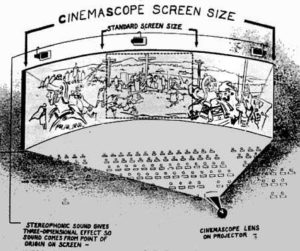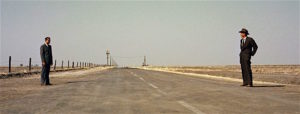 My “Sightings” column, which appears in the online edition of today’s Wall Street Journal, is about TCM Big Screen Classics, which showed North by Northwest in U.S. multiplex cinemas last week. Here’s an excerpt.
My “Sightings” column, which appears in the online edition of today’s Wall Street Journal, is about TCM Big Screen Classics, which showed North by Northwest in U.S. multiplex cinemas last week. Here’s an excerpt.
* * *
Turner Classic Movies, the cable channel that shows uncut, uncolorized classic films around the clock, has done more to improve the lives of movie buffs than anything or anyone since Thomas Edison. TCM’s latest venture, though, is worthy of special note: TCM Big Screen Classics, undertaken in collaboration with Fathom Events, screens classic films each month in multiplexes throughout the U.S. Now that the revival houses that used to show such films on a regular basis are on the way to extinction, most people “know” old movies solely from watching them on TV, or on hand-held devices. Thanks to TCM, you can see them the way they’re supposed to be seen….
Well into the ’60s, movies were normally shown in auditoriums equipped with screens up to 100 feet wide that held between 250 and 1,000 viewers (New York’s Radio City Music Hall seats 6,000). Golden-age directors took it for granted that their work would be seen on such screens, and when Hollywood embraced wide-screen filming in the ’50s to compete with TV, big-theater projection became even more central to the moviegoing experience.
All this started to change with the introduction of multiplex cinemas. Projection screens started shrinking, and theaters that continued to show older films increasingly did so in houses holding no more than 100 viewers. These miniaturized theaters were incapable of providing the eye-popping experience of viewing a classic film on a full-sized screen—and when the same films were reformatted to fit the TV screens of the ’60s and ‘70s, it became even harder for younger viewers to fully appreciate them….
 That’s why I made a point of going to a Big Screen Classics showing of “North by Northwest.” This was the first time that I’d seen Alfred Hitchcock’s 1959 masterpiece of suspense in a theater, and I can’t begin to tell you how many subtle details that typically go unnoticed in your living room all but exploded off the large screen on which I watched the film. Always the most visually minded of golden-age directors, Hitchcock took full advantage of VistaVision, not just in the climactic Mount Rushmore chase scene but throughout the picture. One of the most striking moments in the film comes when Cary Grant and a mysterious stranger stare suspiciously at one another from across a deserted rural highway. Hitchcock places them at the extreme left and right sides of the screen, and when you watch the scene in a theater, the dusty road that separates the two men looks as wide as a canyon.
That’s why I made a point of going to a Big Screen Classics showing of “North by Northwest.” This was the first time that I’d seen Alfred Hitchcock’s 1959 masterpiece of suspense in a theater, and I can’t begin to tell you how many subtle details that typically go unnoticed in your living room all but exploded off the large screen on which I watched the film. Always the most visually minded of golden-age directors, Hitchcock took full advantage of VistaVision, not just in the climactic Mount Rushmore chase scene but throughout the picture. One of the most striking moments in the film comes when Cary Grant and a mysterious stranger stare suspiciously at one another from across a deserted rural highway. Hitchcock places them at the extreme left and right sides of the screen, and when you watch the scene in a theater, the dusty road that separates the two men looks as wide as a canyon.
For me, though, it was even more instructive to watch “North by Northwest” in the company of a theater full of other people, many of whom were clearly seeing the film for the first time. When you’re watching it by yourself, it’s easy to forget that “North by Northwest” is less a cloak-and-dagger adventure story than a high romantic comedy with a light glaze of thriller sauce. Why is this the case? Because most of us tend not to laugh out loud when we’re alone. Not so the audience with whom I saw it last week. Instead of sitting somberly like a bunch of grim-faced graduate students, we all hooted at Ernest Lehman’s fizzy, flawlessly timed one- and two-liners…
* * *
Read the whole thing here.
A scene from North by Northwest:

 •
• 